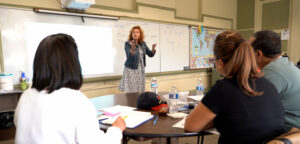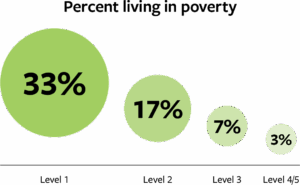The economic and social prosperity and stability of our nation—and our own local communities—depend on the ability of adults to read, write, do basic math, and think critically.
The most recent Survey of Adult Skills data published in December 2024 shows that 28% of American adults read at or below the lowest level assessed. The number of adults with skills at the lowest level grew from 48 million to 59 million since the previous survey was conducted in 2014. These adults lack the foundational literacy, numeracy, and digital skills that would allow them to:
- access post-secondary education,
- acquire and maintain steady employment,
- earn family-sustaining wages,
- engage effectively in their own health care,
- participate in their children’s education, and
- be active members of their community.
Low literacy affects every community in America. Yet, as a nation, we are still not paying enough attention to this issue.

Project Learn of Summit County, Akron, OH
The Survey of Adult Skills measures proficiency from Level 1 to Level 5, with Level 3 as the threshold at which adults have the skills to successfully navigate the demands of everyday life. Many factors contribute to low literacy skills in adults, and adult education programs empower those who struggle with literacy to overcome past barriers and build a new sense of self-efficacy, acquiring skills that will provide new opportunities for a better future.
Advancing from Level 1 to Level 2 proficiency, for example, means a person has gained the skills needed to use information from a chart to determine the proper dose of medication to give their child, or to compare prices in grocery store ads to decide where to shop most economically—everyday skills many people with adequate literacy skills take for granted. Many adults with low literacy skills report they would be interested in improving their skills but are either unaware that programs exist to help them or are apprehensive to enroll because of time constraints, fear of failure, or the negative stigma that is often attached to low skills and needing help.
The Impact of Low Literacy to the Economy
The World Literacy Foundation estimates that low literacy skills cost the US economy $300 billion annually in the form of lost earnings, lower productivity, and higher reliance on government assistance. In addition, when it comes to navigating the health care system, low literacy skills account for an estimated $215 billion in unnecessary spending.
Within four industries that rely on employees to fill low-skilled jobs, 94% of employers surveyed said they have employees who do not have the literacy skills to meet the requirements of the job, costing an estimated $46 billion in revenue annually. For those employees with low literacy levels, the biggest challenges are using digital tools, completing training and development, and performing administrative tasks.
If we want a healthy and self-sufficient citizenry, a skilled workforce, a strong economy and a leading nation, we will make increasing the basic literacy skills of our population a national priority and invest more in adult education.”
“Basic literacy skills among the adult population in the U.S. have been decreasing for the past several decades, a trend that should alarm every citizen and motivate us all to want to address the issue,” said Jeff Fantine, executive director of the National Coalition for Literacy. “Literacy rates affect each of us and impact every aspect of our society. If we want a healthy and self-sufficient citizenry, a skilled workforce, a strong economy and a leading nation, we will make increasing the basic literacy skills of our population a national priority and invest more in adult education.”
Putting Adult Literacy Center Stage
As it stands, adult education programs are reaching less than 10% of individuals who could benefit from these services. Despite meeting a mere fraction of the need, it should be noted that 47% of those who were enrolled in adult education in 2023–2024 improved their skills and opened new doors to fulfilling the demands of everyday life, job advancement, and upward mobility—creating stronger communities and a stronger workforce.
“When you watch an adult discover a newfound sense of pride in themselves, their work, and their contributions to their communities because they learned to read, it’s transformative,” said Mark Vineis, ProLiteracy president and CEO. “Not to mention the economic impact that improved literacy has on an individual who maybe for the first time in their lives can achieve financial independence to provide for their families and experience upward mobility. I can’t think of any other skill that is as life changing as learning to read.”

Nashua Adult Learning Center, Nashua, NH
So, what would be possible if we could do this on a larger scale? How do we build the capacity to serve more learners in need of basic literacy skills?
There is bipartisan agreement that adult education builds more resilient communities. Yet, for years, federal funding has been stagnant, and the same is true within many states and localities, which has restricted the scale of what programs can accomplish.
But when it comes to educating adults, we’re not just throwing money at a problem—we’re investing in a solution. Every dollar directed toward adult education—from government funding to personal and corporate philanthropy—is used to build the capacity of programs so they can more readily set adults on a path to success through:
- Professional learning
Providing quality training for new and existing paid instructors and volunteer tutors prepares them to meet the specific needs of adults. Ongoing training of instructors means programs can better and more efficiently serve adult learners at any given time. - Flexible learning and digital tools
When programs can offer more flexibility and availability, like hybrid learning models and digital tools, their capacity to enroll and retain more adult learners grows. Providing access to digital tools gives adult learners the ability to continue learning outside of class, helping them speed up their skills development. - Developing partnerships
Integrating adult literacy programs into existing social services like food assistance, family support, or housing programs could increase awareness, reduce logistical challenges, and empower individuals to build the skills needed for self-sufficiency. Partnerships like this would both empower the individual while also reducing the need for them to rely on such services.
Every dollar put into adult education pays for itself in the programs’ abilities to build human capital, resulting in increased productivity, economic output, increased tax revenue, and self-efficacy. It’s a guaranteed return on investment.

In the United States, more than 36 million people live in poverty, and 80% of them read at Level 2 or below. But, increasing an adult’s literacy skills one proficiency level, from Level 1 to Level 2, makes it 50% less likely they will live in poverty. Achieving Level 3 proficiency—that level deemed necessary to manage the demands of everyday life—makes it nearly 80% less likely someone will live in poverty or require assistance.
When every adult has the opportunity to build the literacy and numeracy skills needed to manage daily life—from budgeting and employment to health care and parenting—our communities become stronger, more resilient, and more sustainable.
Increasing support for adult education programming is essential to our nation’s future. Our voices are stronger together. Join the movement to raise awareness in your community about the power of adult education and contact your lawmakers to advocate for continued funding.